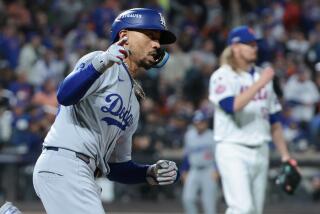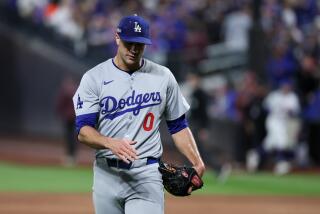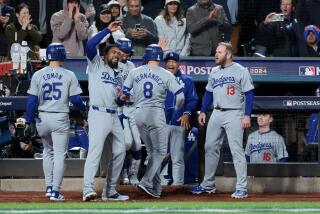Mets Face Many Decisions Without Darryl
- Share via
NEW YORK — Within the next two weeks, one of Darryl Strawberry’s less tolerant former teammates will announce an embargo. “Enough! No more talk about Darryl,” he’ll say. “He’s gone. Let’s get on with this year.”
The talk may, in fact, cease, but the thoughts will not.
The 1991 season will be Vince Coleman’s first with the New York Mets, and it may well be Dwight Gooden’s last. But until the Mets establish an identity and indicate how they will fare without the player who was their primary offensive weapon, occasional leader, foremost enigma and all-time double-edged sword, 1991 will be known as The Mets’ First Season Without Strawberry.
The impact of his absence will be inescapable. Coleman may steal 100 bases, Hubie Brooks and Kevin McReynolds may each drive in 90 runs, Dave Magadan may hit .350 and Gooden may win 20 games. But baseball being baseball, there will be periods when Strawberry’s absence will be conspicuous.
How late into the season such periods develop will depend on how well the Mets perform and how quickly they can purge Strawberry from their memories. If Strawberry is gone from consciousness by July, the Mets will be a competitive, contending team. If the lack-of-lefthanded-power lament still is heard in August, forget about September.
Other factors enter into the Mets’ 1991 equation as well, factors that will begin to take shape in Port St. Lucie, Fla., Friday when pitchers and catchers assemble for the first workout under Manager Bud Harrelson (and without Strawberry, not to mention Davey Johnson).
Harrelson gave mention to operating this training camp as early as last May 29, the day he succeeded Johnson. This will be his camp, with greater emphasis on defense and execution, and its product will be his team. The manager’s goal is to make the Mets better at winning close games. Their 32-42 record in games decided by one or two runs was their undoing last season.
With the pronounced difference in managers, with Strawberry’s power gone and with Coleman now an ally, the philosophy of the offense will be markedly different. Whether the offense will be more consistent, as Harrelson wants, and equally productive -- the Mets led the league in runs last season -- is another matter. The manager intends to rely more on the running game. Tommy Herr and Magadan, the Nos. 2 and 3 batters in Harrelson’s projected batting order, can contribute to the offense as batters. But only Coleman and Howard Johnson are genuine threats to steal.
Although Harrelson seeks a tighter defense, the alignment he has proposed compromises two critical positions -- shortstop and center field -- and creates liabilities that will not be removed by six weeks in Florida. And the rotation, with all its glamour and strikeouts and John Franco, still is undermined by suspect middle relief.
Harrelson, whose handling of the club last summer was not universally hailed, also faces four possibly ugly situations involving Gooden, the catchers, Kevin Elster and Daryl Boston.
The manager has no jurisdiction in the matter of signing Gooden to a contract extension. But if negotiations between the club and Gooden’s agent fail to produce an agreement by Friday, Harrelson will have to deal with the fallout. The fallout could be widespread, touching pitchers Frank Viola and Ron Darling who, like Gooden, are eligible for free agency after this season; Brooks, who can demand a trade after the season, and Coleman, who chose to sign with a contending team that could lose three starting pitchers after his first season.
The catching assignment appears to belong to Charlie O’Brien, the preference of Gooden, Darling, David Cone and, more significantly, General Manager Frank Cashen. Cashen and Harrelson differed in their offseason choice of catcher. Even if they now agree on O’Brien, the best defensive catcher on the team, Mackey Sasser won’t agree. And minimizing Sasser’s left-handed offense might only underscore the loss of Strawberry.
The Elster issue, indirectly connected to the Boston situation, is more immediate; it already is festering. The team’s starting shortstop for 2 1/2 seasons before serious shoulder injury required surgery last summer, Elster has been cast as a backup, a role he will not accept. Cashen has said the club will “have to think of trading him” if and when Elster proves his shoulder is sound. That may be the wisest resolution to this problem. But, other than unproven Kevin Baez, whose offense is quite suspect, the Mets have no legitimate reserve shortstop.
As much as teammates admire Johnson’s work ethic and marvel at his all-around skills, most feel he is best suited to play third base, the position assigned to Gregg Jefferies. Johnson’s work at shortstop last season was as great a revelation as Magadan’s work at first. Johnson was more sure-handed and spectacular than expected, but he didn’t cover the territory Elster had. The starting pitchers prefer Elster at shortstop. If Johnson’s defense falters at all, there will be dissatisfaction.
And, most likely, the discontent will be directed at Jefferies, whose inability to master second base contributed to the decision to move Johnson to shortstop.
Finally, there is Boston, whose surprising contribution last summer seemed overlooked this winter when the outfield was being restocked. He has been pushed out of center field, although he is acknowledged as the team’s best defensive center fielder and though his left-handed offense could be helpful.
Boston has told teammates, “Hubie’s going to have to play third,” a statement that brings into focus several aspects of the Mets’ out-of-position defense. Boston says he should play center between Coleman in left and McReynolds in right. But Harrelson wants Coleman’s speed in the middle. Coleman as a center fielder may be reminiscent of Mickey Rivers with the New York Yankees. Rivers was not a gifted judge of a fly ball, but he was fleet enough to outrun his misjudgments and cover the alleys.
The out-of-position assignments go beyond center, however. The Mets have a third baseman, Brooks, playing rightfield; a third baseman, Johnson, playing shortstop, and a former third baseman, Magadan, playing first. And as one of the caustic pitchers pointed out last month, “One place we don’t have a third baseman is third base.” Jefferies is back for a second tour at third after nearly two full seasons at second. He doesn’t move well to his right, so the down-the-line double may become an effective weapon for opponents.
That change of assignment is based on a factor other than Jefferies’ play at second base -- Harrelson’s desire to have the veteran Herr playing second and batting second behind Coleman. But Herr’s presence raises other questions: Is his range as limited as it appeared last September or was it the effect of a calf injury? And, if Herr bats second, who bats seventh?
Harrelson must find answers for that question and others before the opener April 8 if the Mets are to start off well, as they must to eliminate the feelings of losing Strawberry. But, as the manager has said throughout the winter, “That’s what spring training’s for.”
More to Read
Go beyond the scoreboard
Get the latest on L.A.'s teams in the daily Sports Report newsletter.
You may occasionally receive promotional content from the Los Angeles Times.










